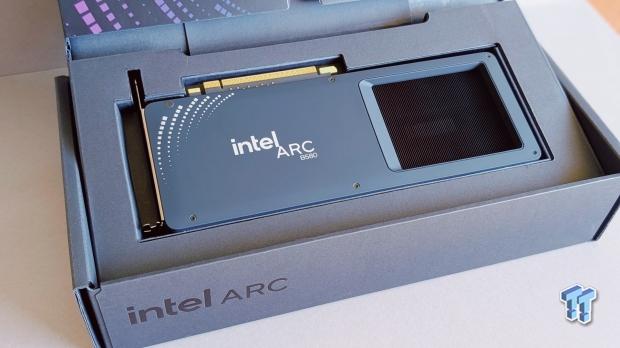
The Bottom Line
Pros
- Second generation Xe2 architecture
- Impressive ray tracing performance
- 12GB of VRAM makes it great for 1440p gaming
- Mature drivers and new in-depth software support
- XeSS 2 Frame Generation shows promise
Cons
- 1080p performance isn't that much better than the RTX 4060
- More power-hungry than its competitors
- DLSS is still the gold standard for Super Resolution and Frame Generation
Should you buy it?
AvoidConsiderShortlistBuyIntroduction
Intel entered the discrete desktop gaming GPU market in 2022 with the arrival of the Intel Arc A750, a new mainstream graphics card designed to offer a viable alternative to the GeForce RTX 3060, which is still one of the most popular cards on the market. Without going into the launch issues, driver problems, bugs, and a long list of unplayable games, it's important to note that the Arc team at Intel has done some impressive work in turning the Arc ship around. Several meaningful driver and software updates, massive improvements to playing games running on older DirectX technology, and more.
A quick look at the Intel Arc B580
From game support to stability to real-world performance, Intel Arc in 2024 is a night and day difference compared to what we saw a few years ago. Even so, the Intel Arc A750 never became a GeForce RTX 3060 killer, and in 2024, Arc Graphics drivers still have plenty of room for improvement. However, the foundation was laid for the arrival of the second generation of Arc graphics hardware and the first 'Battlemage' GPU - the Intel Arc B580. It's an arrival that feels like an Arc 2.0 moment - a reboot, a refresh.
The Intel Arc B580 is a mainstream GPU with 12GB of VRAM and an attractive $249.99 USD price point. This time, Intel is bringing the fight to the GeForce RTX 4060, the RTX 3060's Frame Generation-powered successor. It is more affordable, powerful, and has enough VRAM to make it a capable 1440p gaming GPU. That's Intel's elevator pitch, so to speak, for the Intel Arc B580, which is also debuting alongside the arrival of its Frame Generation technology in the form of Intel XeSS 2 and XeSS-FG.
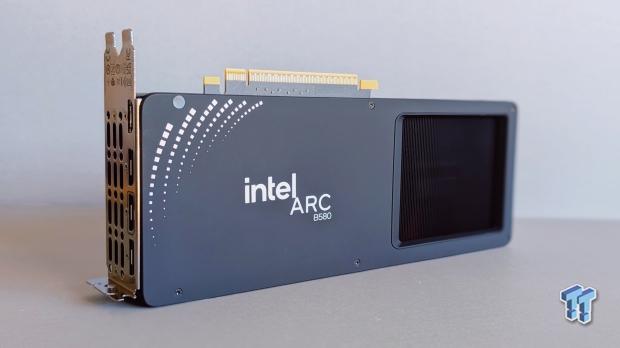
Setting aside the fact that Intel is launching its 'Battlemage' desktop cards with the lower-tier Intel Arc B580 rather than an Intel Arc B750, the B580 more than lives up to its promise of delivering a viable alternative to the GeForce RTX 4060. It might not be the "1440p Ultra" settings GPU like the GeForce RTX 4070, but it's powerful enough to bring the fight to the GeForce RTX 4060 Ti in several games, with ray-tracing and overall performance that makes AMD's mainstream Radeon RX 7600 8GB GPU feel irrelevant.
The Intel Arc B580 is worth considering and something to celebrate. It presents mainstream competition that pressures NVIDIA and AMD to deliver with the upcoming GeForce RTX 5060 and Radeon RX 8600 GPUs in 2025. It's not without flaws, but it's an exciting GPU release nonetheless. Let's dig in.

Intel Arc 2.0 - Battlemage Arrives
Below is a summary of Intel Arc B-Series 'Battlemage' technology in the Intel Arc B580, applicable to all models.
The Intel Arc B580 utilizes the company's second-generation Xe2 HPG or High-Performance Graphics architecture. Compared to NVIDIA's CUDA Cores and AMD's Compute Units, Intel's Xe and now Xe2 architecture breaks down its technology into 'Render Slices,' which contain Xe Cores, Ray Tracing Units, and dedicated Intel XMX AI hardware. These are the building blocks that make up graphics rendering in the modern era, where it's a mix of GPU hardware, AI hardware for boosting performance, and Ray Tracing hardware to process the complex calculations required to deliver genuinely stunning cinematic gaming.
As expected, Intel's B-Series moves to a more efficient and cutting-edge process in the form of TSMC 5N. However, this only plays a minor role in each next-gen Xe Core, delivering up to 70% more performance with a 50% improvement in power efficiency. Intel's first-generation Xe architecture and Arc graphics products were impressively engineered, but there was room for improvement. With enhanced compatibility with graphics engines and APIs like DirectX and Vulkan, improved workload distribution, more cache, expanded AI hardware, and more than double the overall ray tracing performance, Xe2 sees the Arc team return to the drawing board to bring measurable improvements to its second-generation Arc Graphics products.
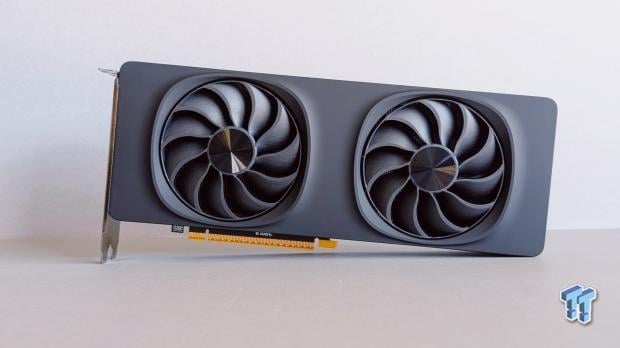
The proof, as they say, is in the pudding. The Intel Arc B580 features 20 Xe Cores compared to 28 Xe Cores in the first-gen Intel Arc A750, roughly a 28% reduction in overall GPU hardware. And yet, it still manages to deliver a sizeable 30% improvement in 1080p gaming performance. Arc 'Battlemage' and the Xe2 architecture have also been designed for integrated graphics, as seen in Intel's mobile Lunar Lake chips. So, it makes sense that an entry-level desktop GPU product would improve performance and efficiency.
Xe2 is also forward-thinking in featuring fixed-function engines within the GPU for rasterization, ray tracing, and DirectX 12 Ultimate technologies like Variable Rate Shading, Mesh Shading, and Sampler Feedback. In developing Xe2, Intel's engineers and architects analyzed various workloads, covering all engines and rendering APIs to improve latency, performance, and efficiency. The team also focused on software and hardware interactions, with some executions improving a massive 66X compared to the first-generation Xe architecture.
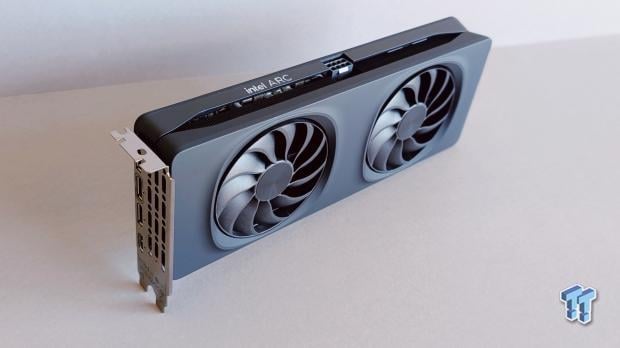
The Intel Arc B580 also sees the arrival of Intel XeSS 2 for all Arc devices, which combines the AI-powered XeSS Super Resolution upscaling with the brand-new XeSS-FG Frame Generation and XeSS-LL Low Latency technologies. Essentially, XeSS 2 is Intel's answer to NVIDIA's DLSS 3, which combines NVIDIA's Super Resolution technology with Frame Generation and Reflex. With AI-based super-resolution and frame interpolation, Intel's tech is closer to NVIDIA than AMD's. Currently only available in a single title, F1 24, XeSS 2 is a welcome addition to the Arc line-up, offering its version of what has become a GeForce RTX selling point.
Finally, for creators, the updated Arc B-Series Media Engine features a new dual-MFX design for encoding and decoding workloads - and can handle up to 8K 10-bit HDR 120 FPS video. With support for a wide range of codecs, including AV1, H265, and HEVC 4:2:2 10-bit encoding and decoding, the Intel Arc B580 is built for media production, streaming, and content creation. The Arc B-Series Display Engine, as seen in the Intel Arc B580, supports up to four monitors at 4K120 HDR with DisplayPort 2.1 and HDMI 2.1a.
Specs and Test System
Specifications
The Intel Arc B580 is the first second-gen Arc desktop graphics card to launch with the new Xe2 'Battlemage' architecture. As the model name suggests, this is a direct successor to the Intel Arc A580, a cut-down entry-level Arc GPU that debuted several months after the Intel Arc A750. Yes, it's a little strange that this time around, Intel is launching its new GPU line-up with an entry-level model - but it makes sense when you factor in NVIDIA and AMD prepping to launch mid-range and high-end GPUs in early 2025. Performance-wise, the Intel Arc B580 is a notable improvement over the Intel Arc A750, making it a viable mainstream alternative to GeForce RTX.
| GPU Specs | Intel Arc B580 | Intel Arc B570 | Intel Arc A750 | Intel Arc A580 |
|---|---|---|---|---|
| Architecture | Xe2 HPG | Xe2 HPG | Xe HPG | Xe HPG |
| Process | TSMC N5 | TSMC N5 | TSMC N6 | TSMC N6 |
| Xe Cores | 20 | 18 | 28 | 24 |
| Ray Tracing Units | 20 | 18 | 28 | 24 |
| XMX AI Engines | 160 | 144 | 448 | 384 |
| Graphics Clock | 2670 MHz | 2500 MHz | 2050 MHz | 2100 MHz |
| Memory | 12 GB GDDR6 | 10 GB GDDR6 | 8 GB GDDR6 | 8 GB GDDR6 |
| Memory Interface | 192 bit | 160 bit | 256-bit | 256-bit |
| Memory Bandwidth | 456 GB/s | 380 GB/s | 512 GB/s | 512 GB/s |
| AI TOPs | 233 | 203 | - | - |
| TBP | 190W | 150W | 225W | 185W |
With fewer Xe Cores than the Arc A750 and Arc B580 and lower memory bandwidth than the Intel, Arc B580 is all about doing more with less; however, the power rating is close enough to the Arc A750 and A580 to suggest that the efficiency gains are somewhat off. That is until you look at the significant boost to clock speeds, with the B580 hitting a peak of 2850 MHz and increasing memory capacity to 12GB of GDDR6. The expanded VRAM capacity helps the Arc B580 handle VRAM-intensive titles at both 1080p and 1440p, like Horizon Forbidden West, to deliver exceptional performance when stacked up against 8GB GPUs like the GeForce RTX 4060, the RTX 4060 Ti, and the Radeon RX 7600.
As seen above, Intel plans to launch a cut-down Intel Arc B570 in January 2025, featuring fewer Xe Cores and 10GB of VRAM.
| Item | Details |
|---|---|
| Product Name | Intel Arc B580 Limited Edition |
| Chip | BMG-21 |
| Architecture | Xe2 |
| Process | TSMC N5 |
| Transistor Count | 19.6 Billion |
| Die Size | 272mm squared |
| Xe Cores | 20 |
| Ray Tracing Units | 20 |
| XMX Matrix Engines | 160 |
| Graphics Clock | 2670 MHz |
| Peak Clock | 2850 MHz |
| Memory Size | 12GB DDR6 |
| Memory Interface | 192-bit, 19 Gbps |
| Memory Bandwidth | 456 GB/s |
| PCIe Interface | x8 Gen4 |
| Total Board Power (TBP) | 190W |
Kosta's Test System
| Item | Details |
|---|---|
| Motherboard | ASUS ROG CROSSHAIR X670E HERO |
| CPU | AMD Ryzen 9 7950X |
| GPU | NVIDIA GeForce RTX 4090 Founders Edition |
| Display | MSI MAG 321UPX QD-OLED 4K 240 Hz |
| Cooler | ASUS ROG RYUO III 360 ARGB |
| RAM | 32GB DDR5-6000 Corsair DOMINATOR TITANIUM RGB |
| SSD | Sabrent Rocket 4 Plus-G M.2 PCIe Gen 4 SSD 4TB, Sabrent Rocket 4 Plus Plus M.2 PCIe Gen 4 SSD 8TB |
| Power Supply | ASUS TUF Gaming 1000W Gold |
| Case | Corsair 5000D AIRFLOW Tempered Glass Mid-Tower ATX PC Case |
| OS | Microsoft Windows 11 Pro 64-bit |
Physical Design and Cooling
The Intel Arc B580 Limited Edition graphics card is Intel's reference model or 'Founder Edition' design. It takes the original look, feel, and cooling configuration of the original Intel Arc A-Series Limited Edition GPU design and redesigns the thermals solution and cooling for improved acoustics (i.e., silent performance) and efficiency.
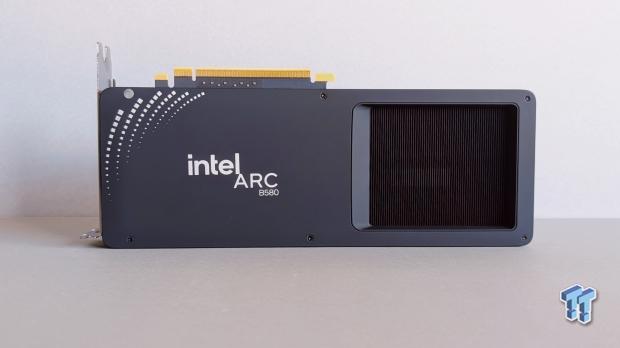
The physical design doesn't include any RGB lighting. Instead, you've got a 'stealth black' dual-fan setup in a compact dual-slot form factor. The cooling comprises four heat pipes with two large vertically oriented fin stacks that run the length of the GPU, with the heat exhausted from the top, bottom, and via the new cooling vent on the back. The back is where you get the GPU's Intel Arc B580 branding with a small pattern. It has an impressive, sleek, and minimalist look, and compared to the Intel Arc A750 Limited Edition GPU, it's considerably lighter - 785 grams versus 1065 grams.
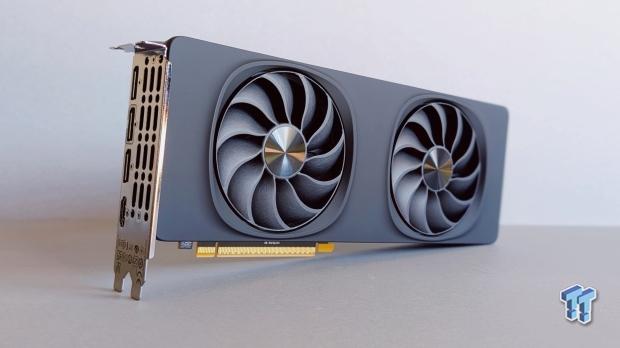
The matte black finish looks great, as does the visible vent on the back of the GPU. As the reference design, Intel has also improved the internal PCB with improved power delivery for the GPU and memory that supports higher speeds, 19 Gbps memory, and clock speeds. This time, Intel uses higher-quality thermal pads and materials for better heat dissipation and an easily removable backplate for repairability and disassembly. Finally, the fans offer 30% improved airflow while reducing noise levels by up to 50%.
Benchmarks - Game Averages
The Games and Tests
PC gaming not only covers a wide range of genres and styles, from indie games with simple 2D graphics to massive 3D worlds lit by cutting-edge real-time ray tracing technology. With that, the needs and requirements of each gamer vary. High refresh rates and latency reduction become more important than flashy visuals or playing at the highest resolution possible for those who live and breathe fast-paced competitive games. For those who want to live in a cinematic world and become a key player in an expansive narrative, high-fidelity visuals are a stepping stone toward immersion.
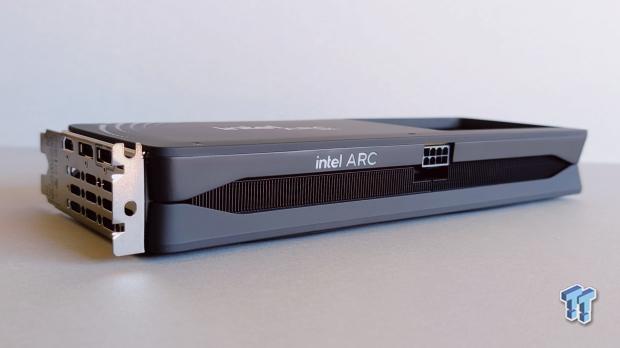
Our chosen benchmarks cover various games, engines, APIs, and technologies. For the Intel Arc B580, all tests are run at 1080p and 1440p and include results for performance-boosting Super Resolution technologies like NVIDIA DLSS, AMD FSR, and Intel XeSS. These technologies are becoming increasingly important, with every major release launching with one or more supported Super Resolution technologies.
In many ways, DLSS numbers are more important in 2024 than native rendering - a title with ray tracing isn't meant to be played without Super Resolution. However, our benchmark results are still sorted using the 'raw performance' native rendering metric as DLSS, FSR, and XeSS are three different implementations of the same thing.
Here's the breakdown of games, graphics settings, and what's being tested.
| Game | Details |
|---|---|
| Black Myth: Wukong | A high-impact Unreal Engine 5 test with DLSS, FSR, and XeSS. The in-game benchmark tool with the 'Very High' fidelity setting and 'Full Ray Tracing' ' turned off is used. |
| Call of Duty: Black Ops 6 | Competitive multiplayer FPS test with DLSS, FSR, and XeSS - the in-game multiplayer benchmark tool is used with Ultra quality settings. |
| Counter-Strike 2 | Competitive multiplayer FPS test running on Valve's Source 2 engine. A stress test mod map is used to showcase CS2 at its most demanding. |
| Cyberpunk 2077 | Cinematic open-world test with stunning visuals and DLSS, FSR, and XeSS. The in-game benchmark tool is used with 'Ultra' quality settings. |
| Cyberpunk 2077 (RT) | Cinematic open-world test with stunning visuals and DLSS, FSR, and XeSS. The in-game benchmark tool is used with the demanding 'Ray Tracing Ultra' quality setting. |
| DOOM Eternal (RT) | Fast-paced single-player FPS gaming running on the id Tech and Vulkan with DLSS. The Mars Core campaign mission is used to benchmark. |
| Dying Light 2 (RT) | Cinematic open-world test with stunning visuals and DLSS, FSR, and XeSS. The in-game benchmark tool is used with the demanding 'High Quality Ray Tracing' setting. |
| F1 24 (RT) | Racing game with hardware-intensive in-race ray-traced visuals and DLSS, FSR, and XeSS. The in-game benchmark tool is used, with 'Ultra High' quality settings on a single lap of the Bahrain track. |
| Forza Horizon 5 (RT) | Racing game with low-impact in-race ray-tracing and DLSS, FSR, and XeSS. The in-game benchmark tool is used with the 'Extreme' quality setting. |
| Horizon Forbidden West | Cinematic open-world test with stunning visuals and DLSS, FSR, and XeSS. The opening section is tested using the 'Very High' quality setting. |
| Total War: Warhammer III | Action-packed real-time strategy with hundreds of on-screen characters. The in-game 'Battle' benchmark tool is used with the 'Ultra' quality setting. |
Average Gaming Performance - 1080p Results
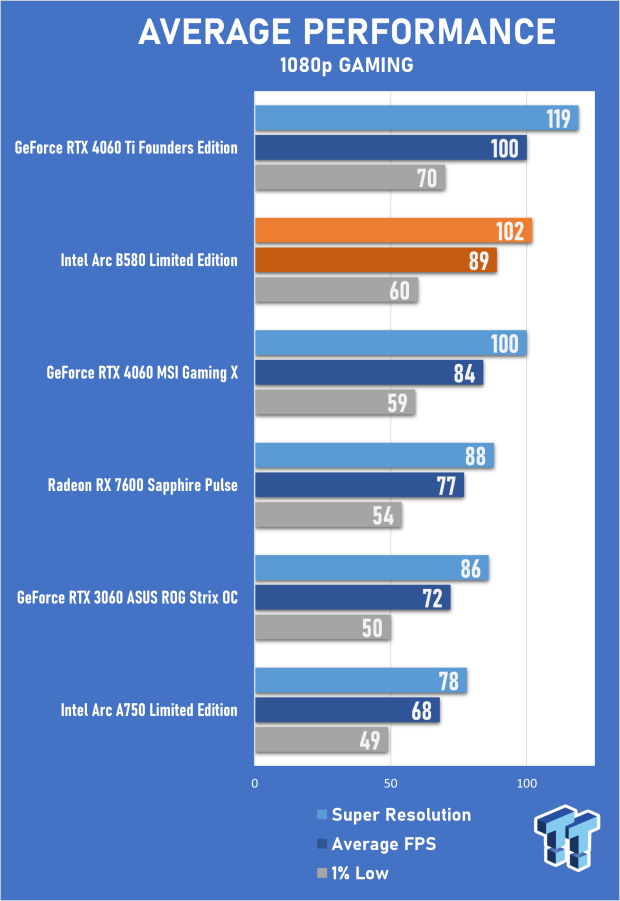
With a wide range of games and genres tested, around half including some form of ray tracing, it's clear that the Intel Arc B580 is more powerful than the GeForce RTX 4060 at this resolution - however, the lead is only around 6%. Even though there are games, like Black Myth: Wukong and Call of Duty: Black Ops 6, where the GeForce RTX 4060 pulls ahead, the Intel Arc B580's performance is far more consistent than that of the first-gen Arc.
There are games where the B580 showcases impressive and surprising gains over the GeForce RTX 4060. Cyberpunk 2077 with ray tracing is 14.7% faster, and Horizon Forbidden West is 10.3% faster. The latter doesn't include ray tracing but is easily one of the best-looking games you can play in 2024.
However, the Intel Arc B580 uses considerably more power than the GeForce RTX 4060, so NVIDIA's mainstream Ada GPU is still the undisputed efficiency champ - drawing as little as 100W even when stressed. The B580 is even more power-hungry than the GeForce RTX 4060 Ti and AMD's Radeon RX 7600. Regarding the Intel Arc B580 versus the Radeon RX 7600, another 12GB of VRAM versus 8GB showdown, the B580 is 15.6% faster on average due to Radeon ray-tracing performance being notably worse. In fact, with the B580's RT capabilities outshining the RTX 4060, performance-wise, as DLSS is still superior to XeSS, the Radeon RX 7600 is wholly outclassed.
Average Gaming Performance - 1440p Results
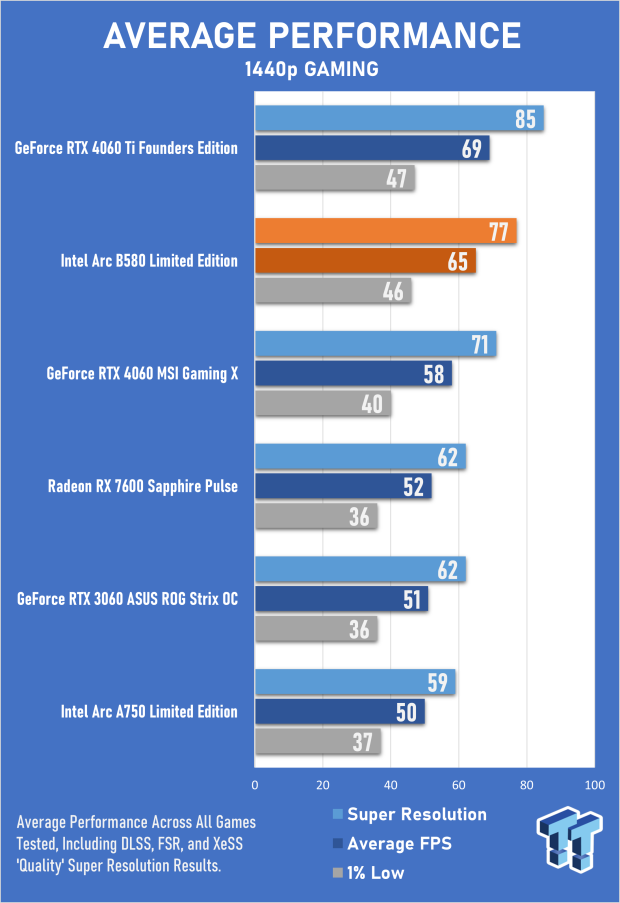
Bump up the resolution to 1440p, and the Intel Arc B580's lead over the GeForce RTX 4060 effectively doubles - to around 12%. One of the reasons for this can be chalked up to the increased 12GB of VRAM, and with an average XeSS-powered average of 77 FPS, the B580 can deliver solid 1440p gaming performance. At 1440p, the AI-powered XeSS (recently updated to XeSS 2) delivers impressive visual fidelity that, although not on par with the gold standard that is NVIDIA DLSS, is closer to DLSS than it is AMD's FSR.
However, it's worth stating that NVIDIA has always marketed the GeForce RTX 4060 as a 1080p gaming card first and foremost. Even with the additional VRAM, the Arc B580's performance in Black Myth: Wukong and Call of Duty: Black Ops 6 still falls behind that of the GeForce RTX 4060. Still, in Horizon Forbidden West, the 12GB of VRAM sees the Intel Arc B580 perform over 20% faster than the GeForce RTX 4060. This example is also faster than the GeForce RTX 4060 Ti, NVIDIA's more expensive mainstream option, pointing to the 12GB of VRAM in the Intel Arc B580, giving it an edge in specific titles.
Regarding 1440p gaming, the Intel Arc B580 is 25% faster than the Radeon RX 7600 - again, a result that makes AMD's mainstream GPU look outdated in terms of its capabilities. With all benchmarks using 'Ultra' or 'Very High' equivalent settings, the Intel Arc B580's performance can be further tuned for additional performance by tweaking in-game settings without adversely affecting image quality.
Benchmarks - 3DMark Synthetic Tests
3DMark offers a suite of synthetic benchmarks built to put GPUs to the test in various scenarios. 3DMark Time Spy is a DirectX 12 benchmark that has been around for a while, which tests rendering at 1440p, which isn't too taxing on modern GPUs. 3DMark Steel Nomad is another DirectX 12 benchmark, but it features newer modern rendering techniques designed to push modern GPUs to their limit. The 'Light' version tests at 1440p, while the main Steel Nomad benchmark tests pure native 4K rendering. Finally, Port Royal is a benchmark focusing exclusively on real-time ray tracing for lighting effects like reflections, shadows, and more.
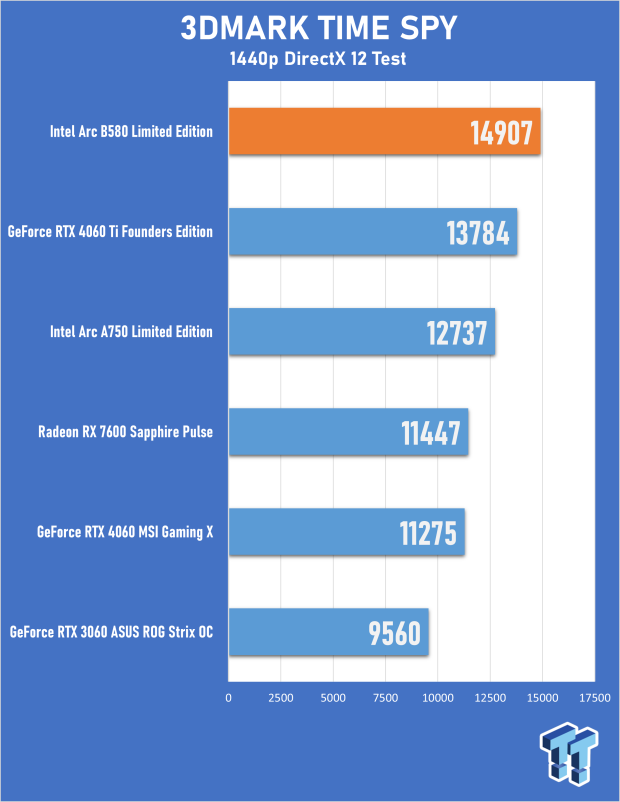
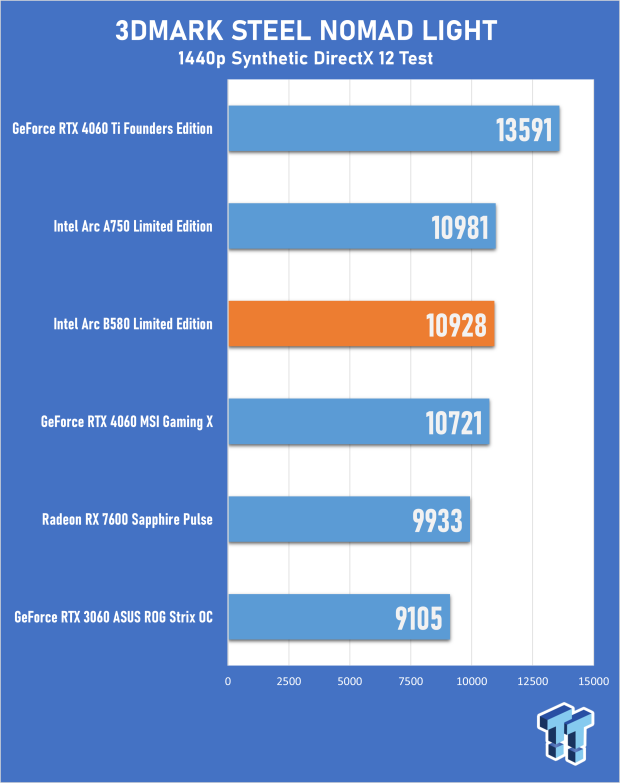
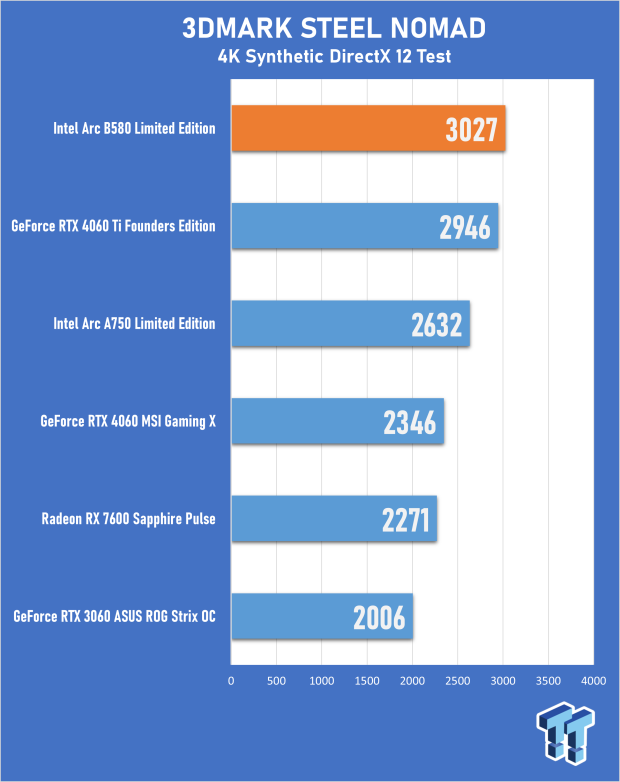
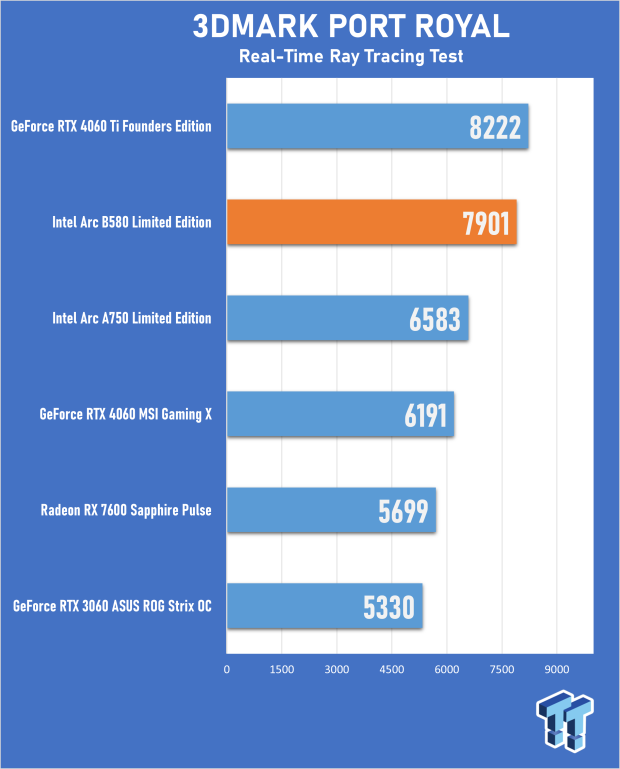
Intel's Arc Graphics has consistently delivered exceptional results in the Time Spy test, which wasn't reflected in actual in-game performance benchmarks. Here, the new Intel Arc B580 outperforms the Radeon RX 7600 by 30.2%, the GeForce RTX 4060 by 17%, and the GeForce RTX 4060 Ti by 8%.
This isn't indicative of in-game results; however, the Steel Nomad Light and Steel Nomad results are much closer to real-world performance. The B580 falls between the RTX 4060 and the RTX 4060 Ti in the 1440p 'Light' version, but thanks to the increased VRAM capacity, it slightly outperforms the RTX 4060 Ti in the 4K test.
Regarding the Port Royal benchmark, we get to see the Arc B-Series ray tracing performance in full force, which leaves the Radeon RX 7600 in its wake while comfortably outperforming the GeForce RTX 4060.
Benchmarks - 1080p Gaming
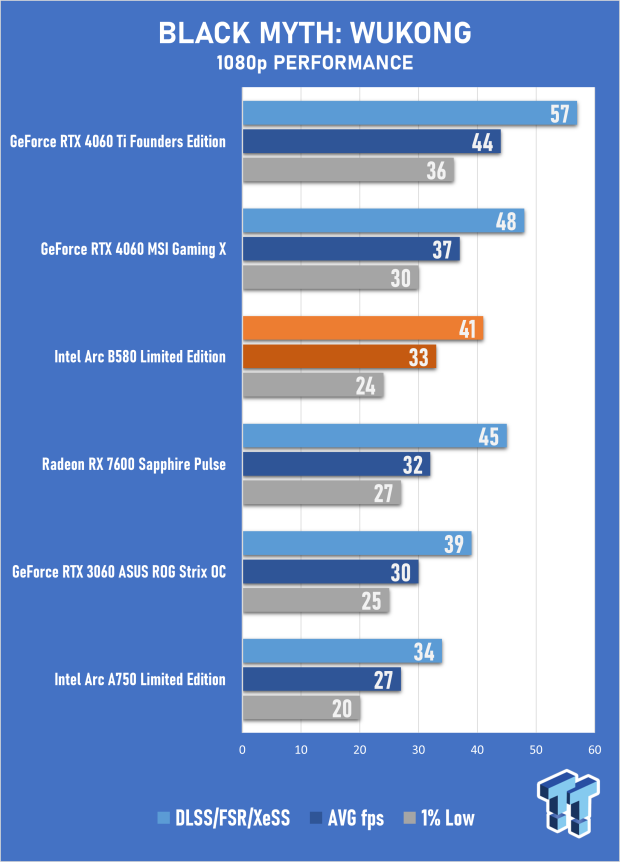
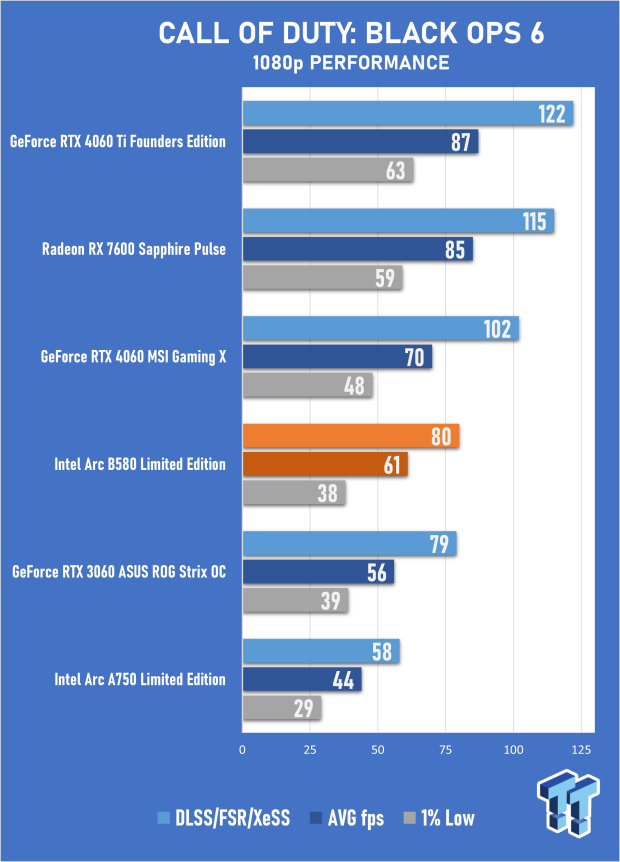
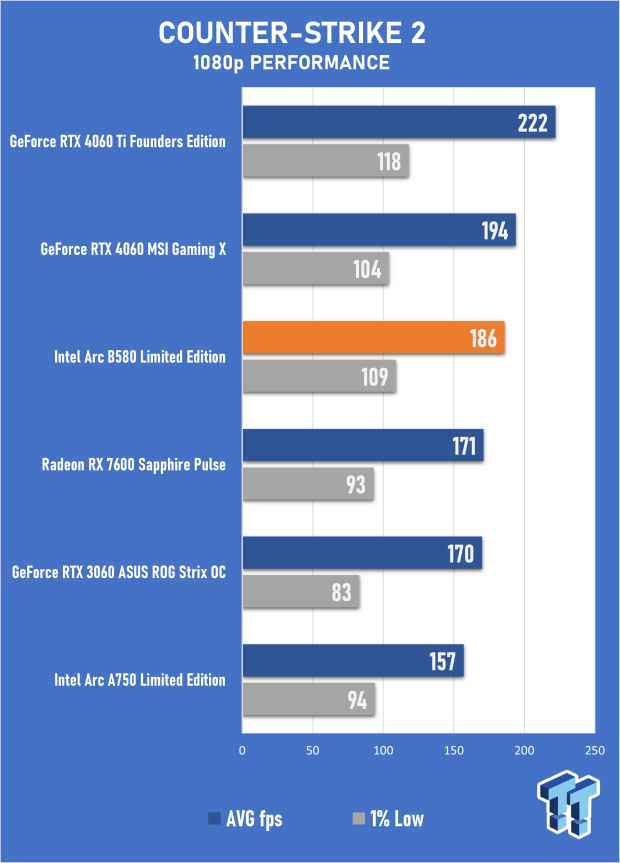
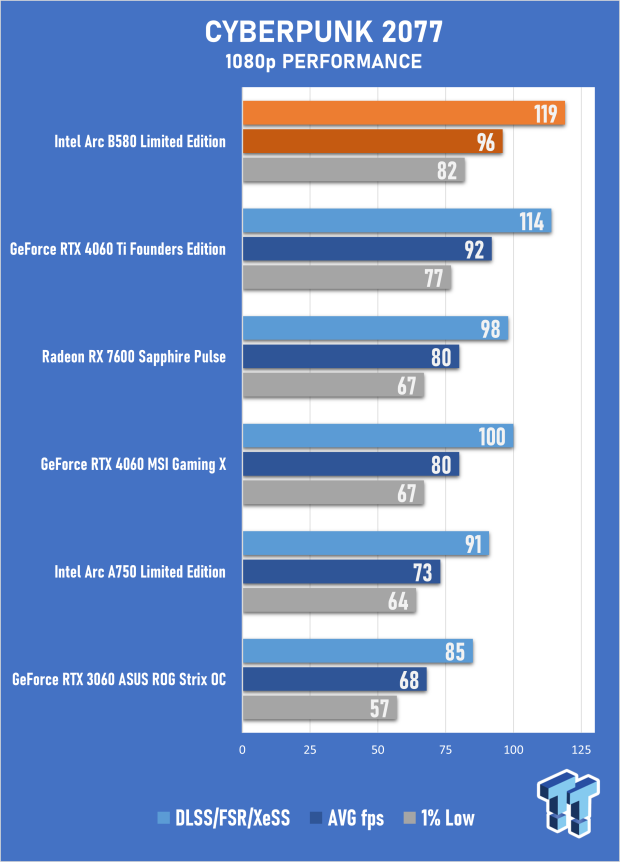
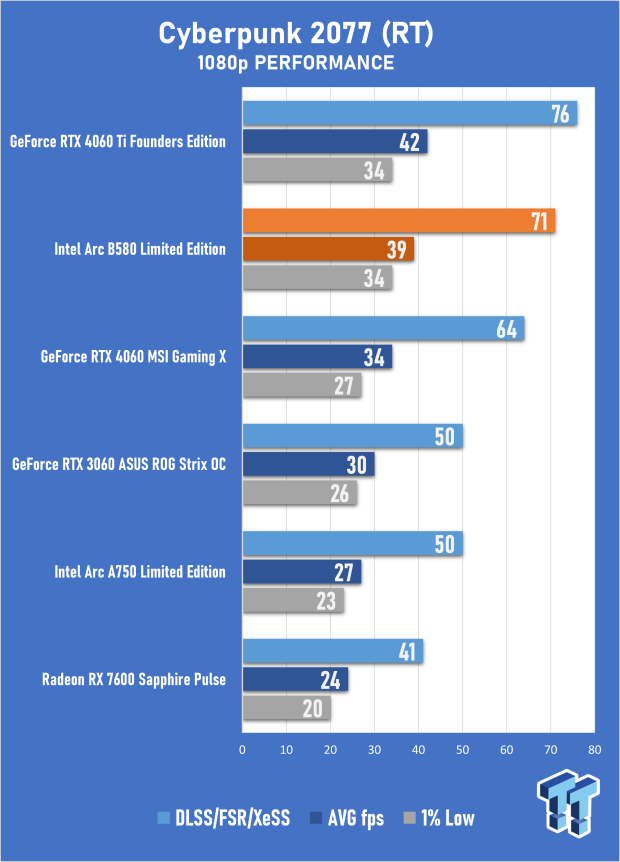
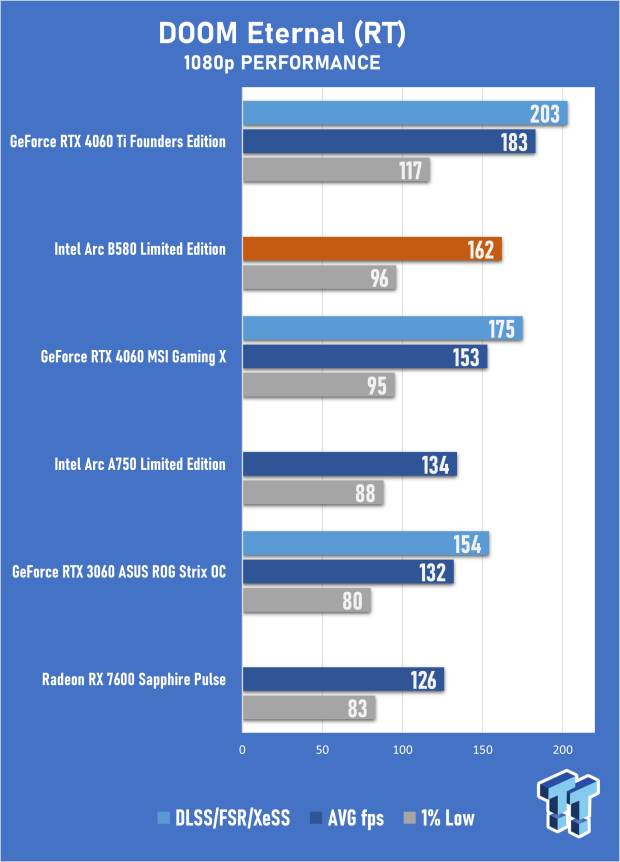
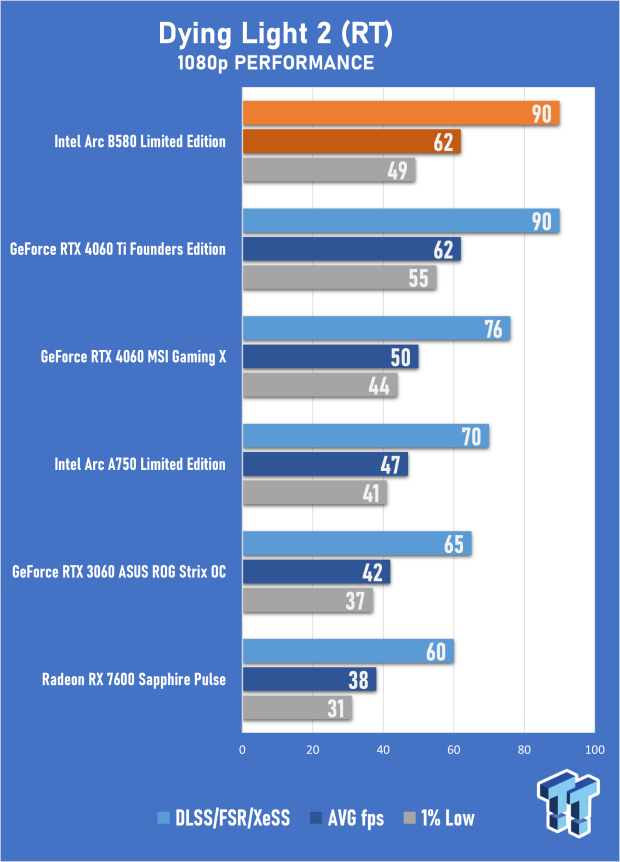
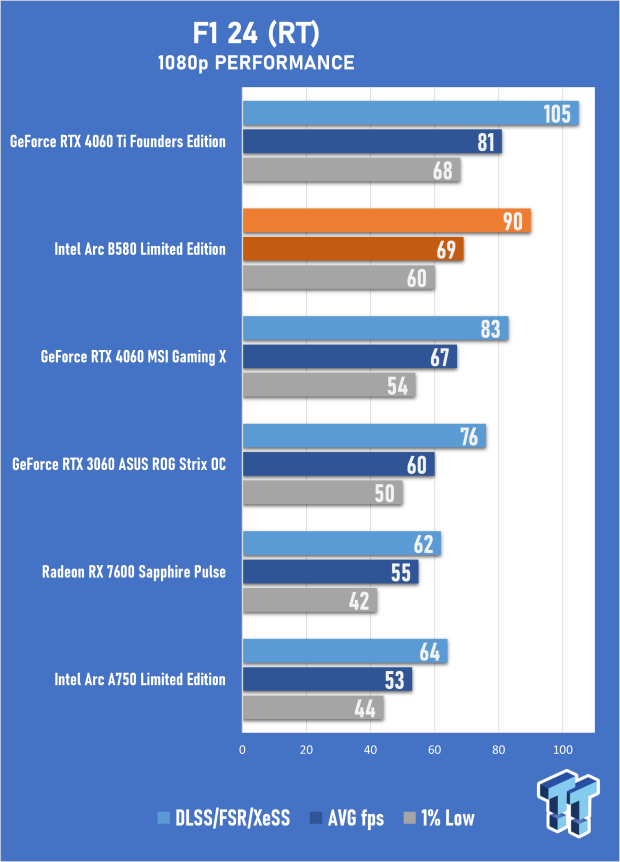
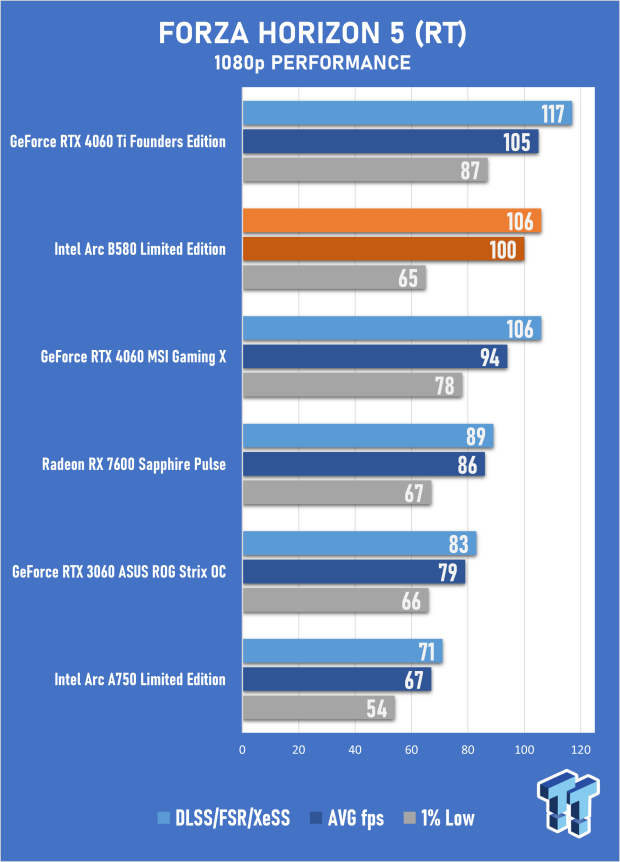
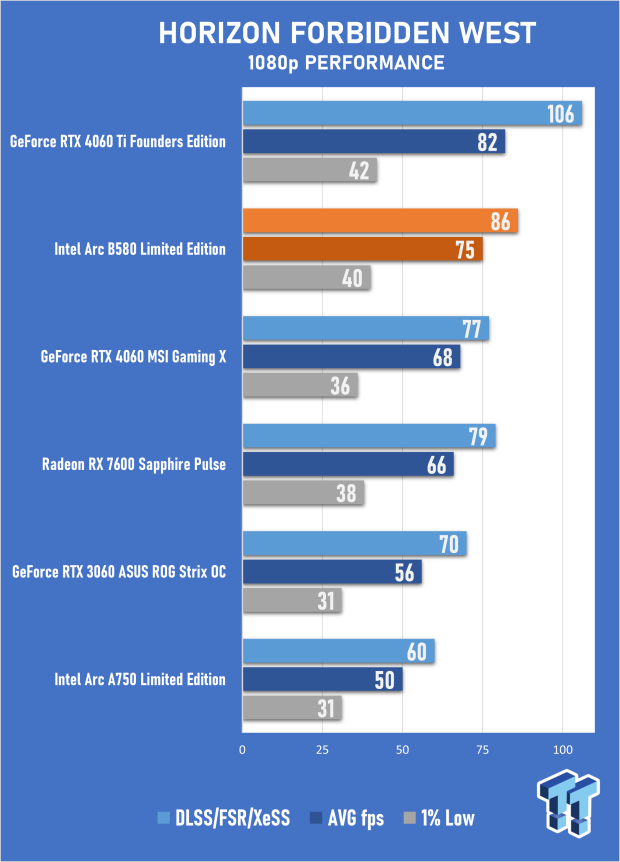
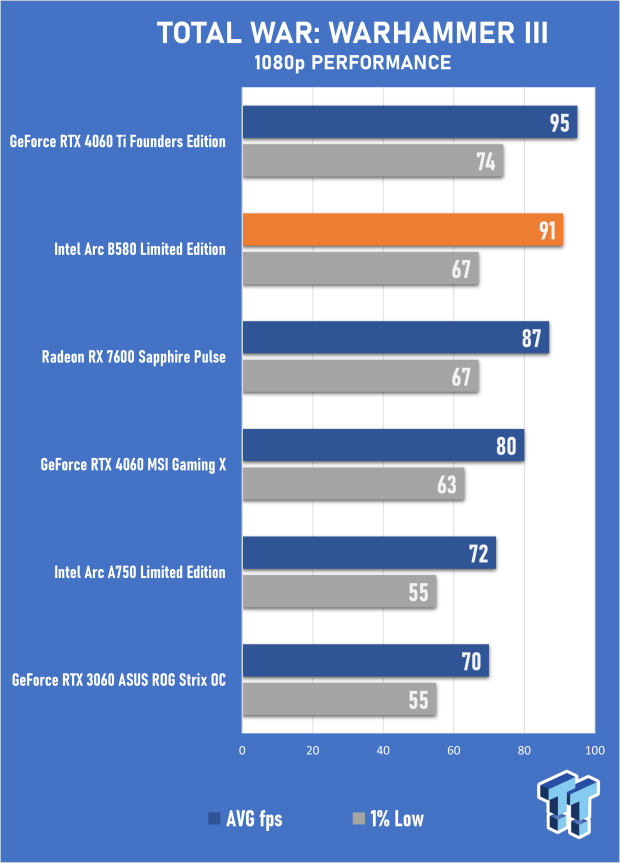
Benchmarks - 1440p Gaming
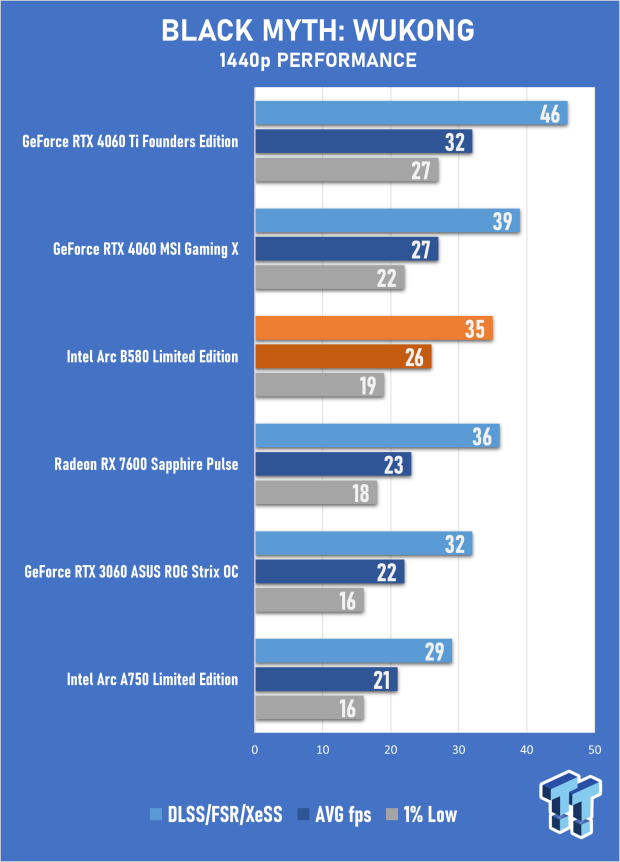
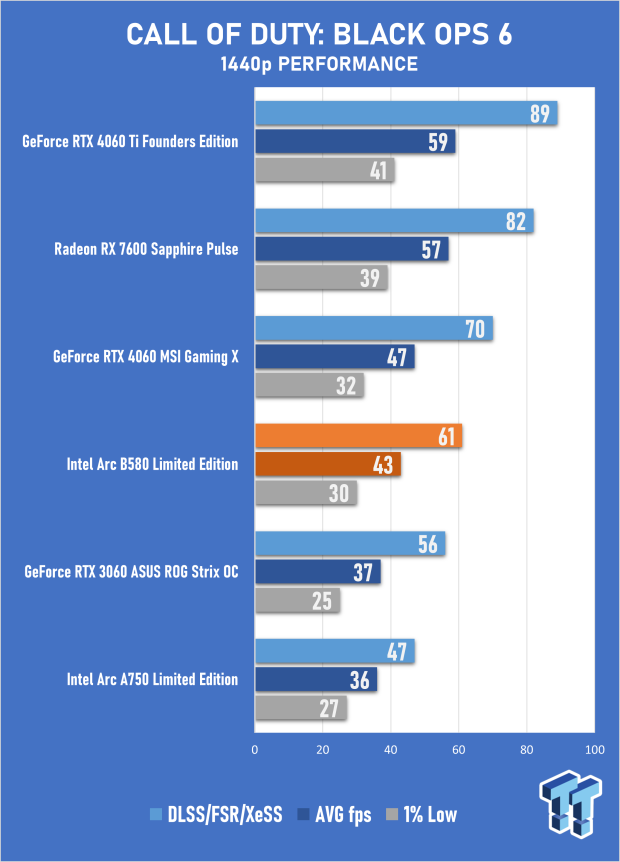
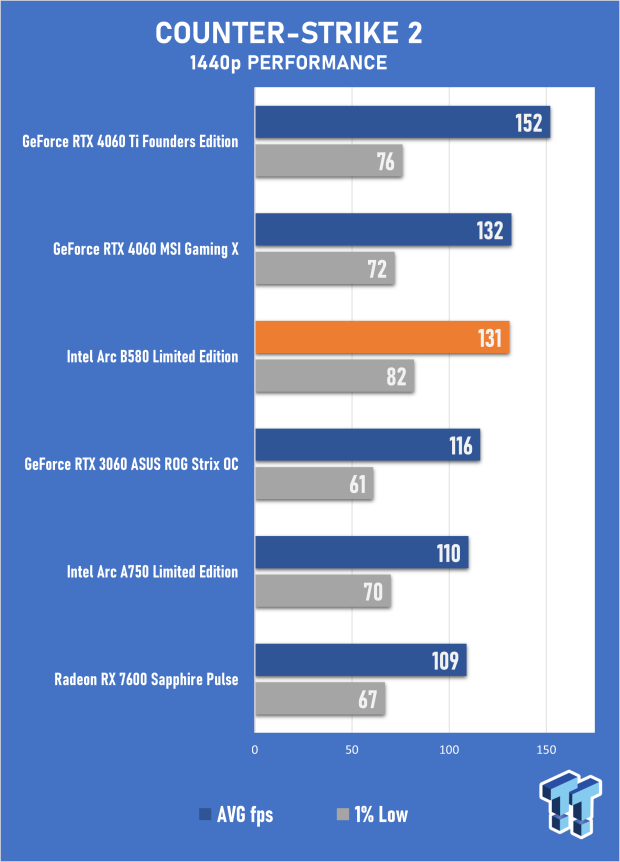
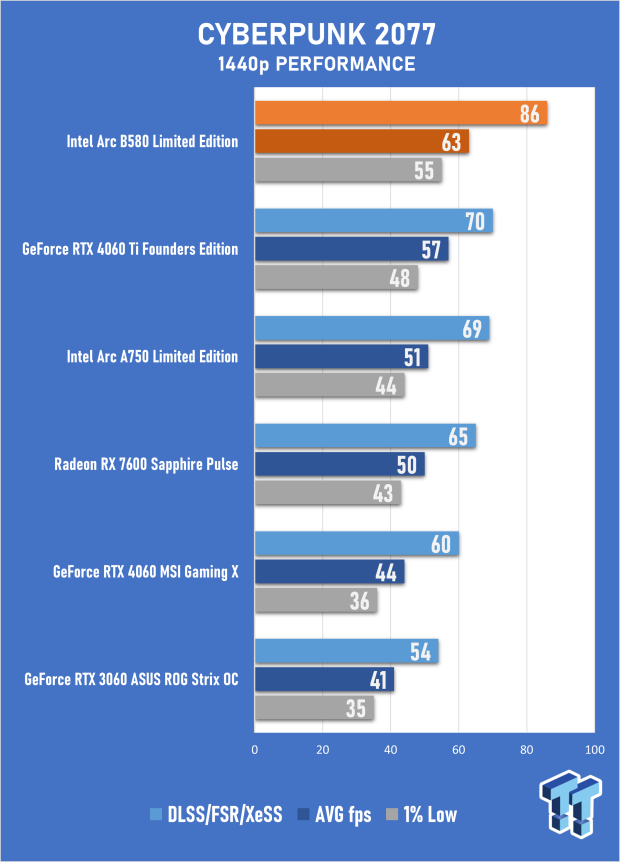
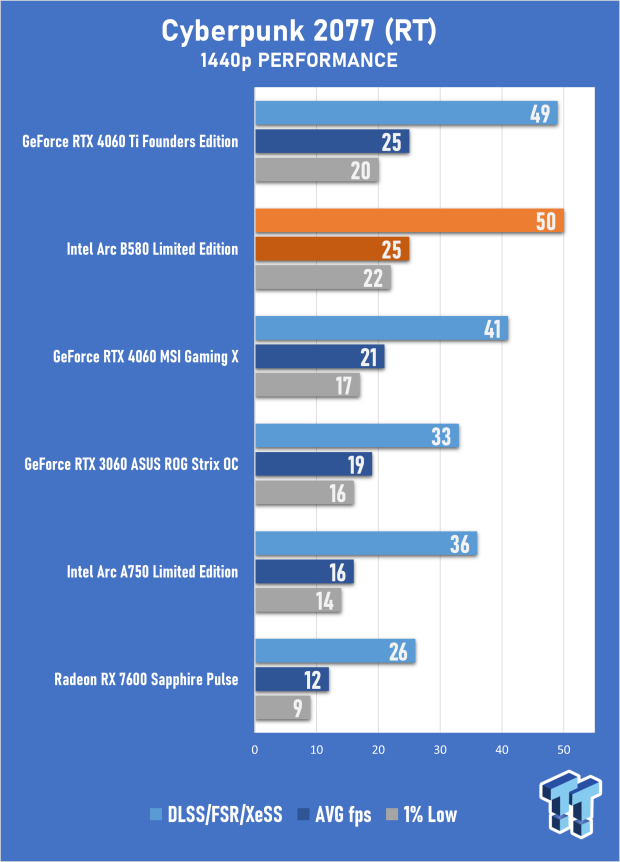
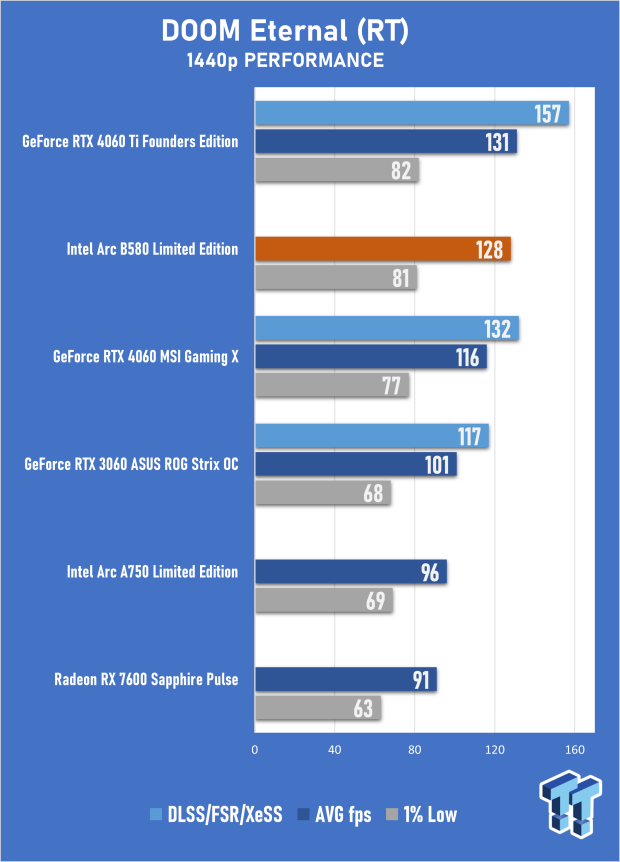
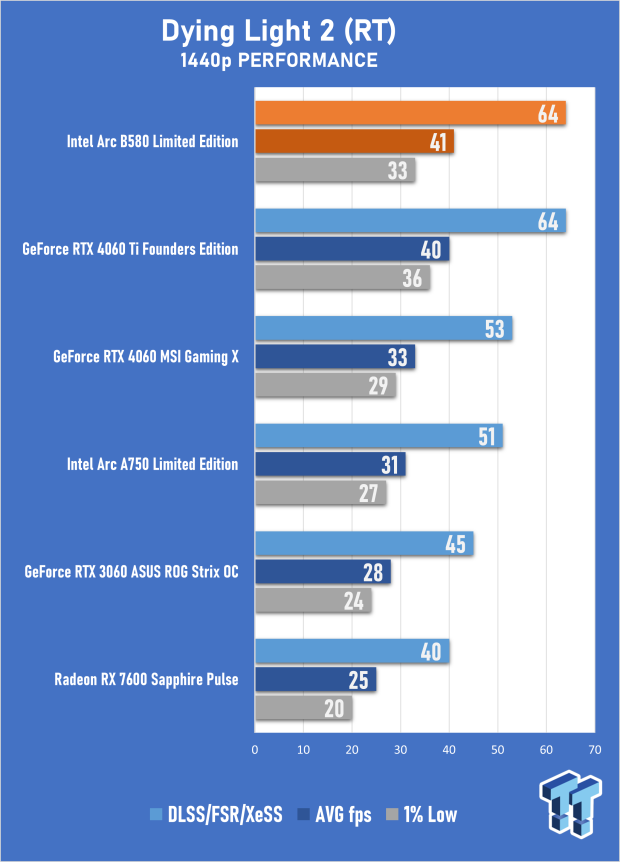
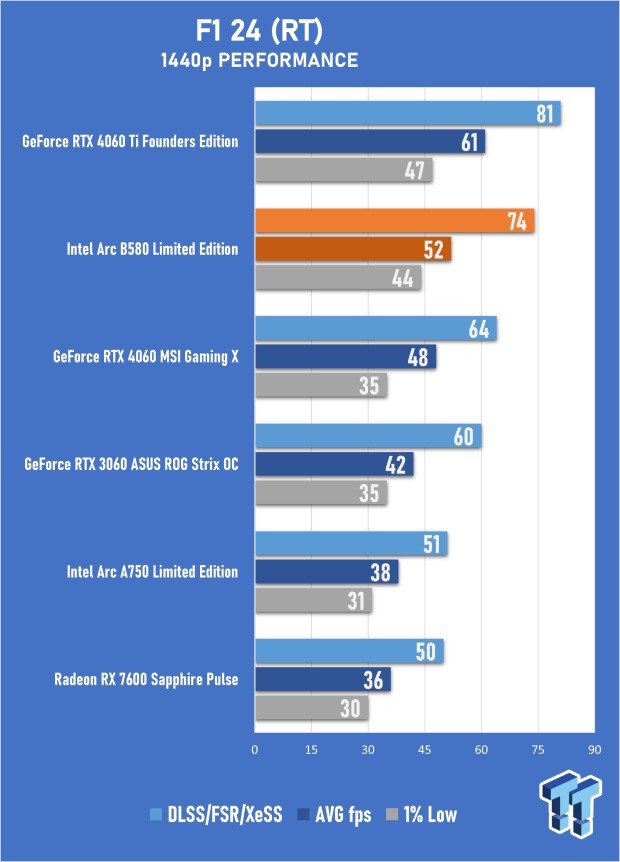
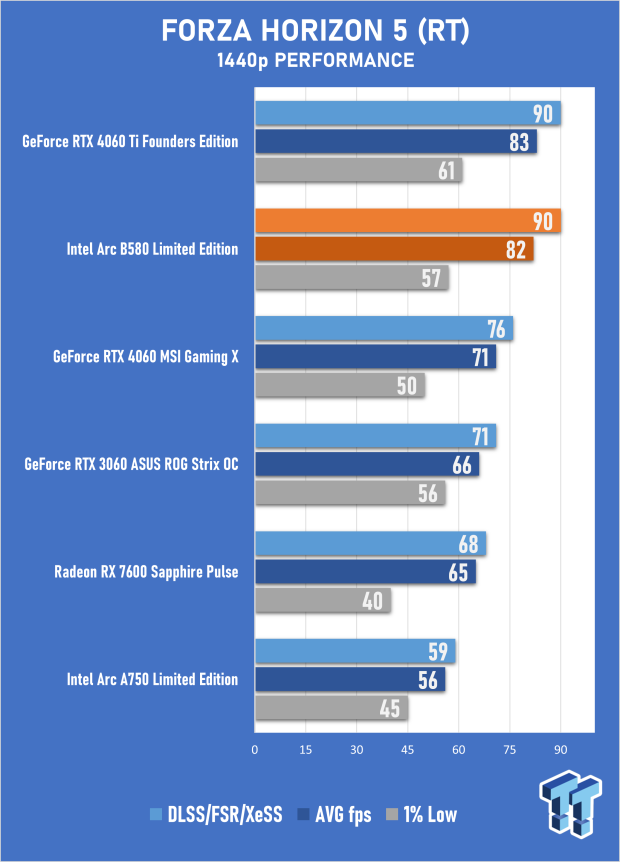
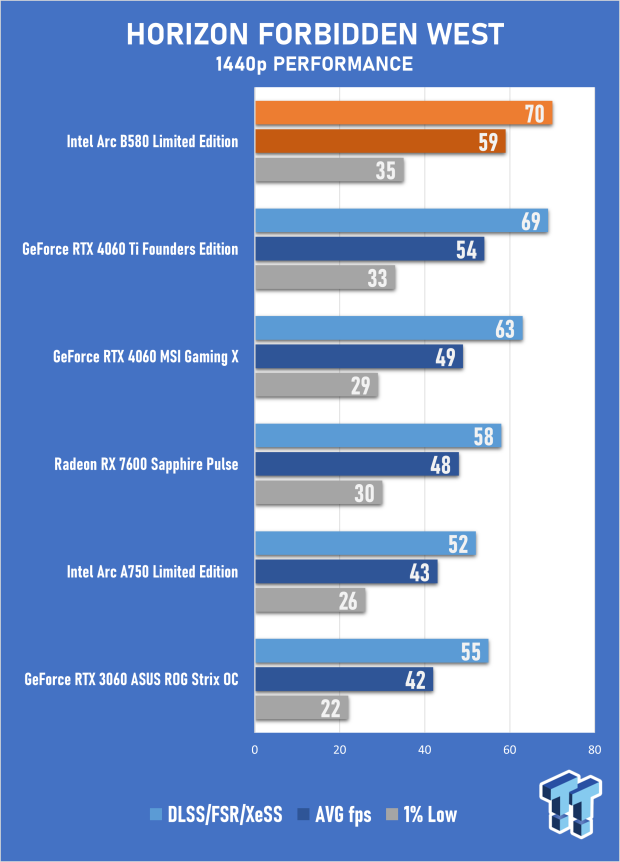
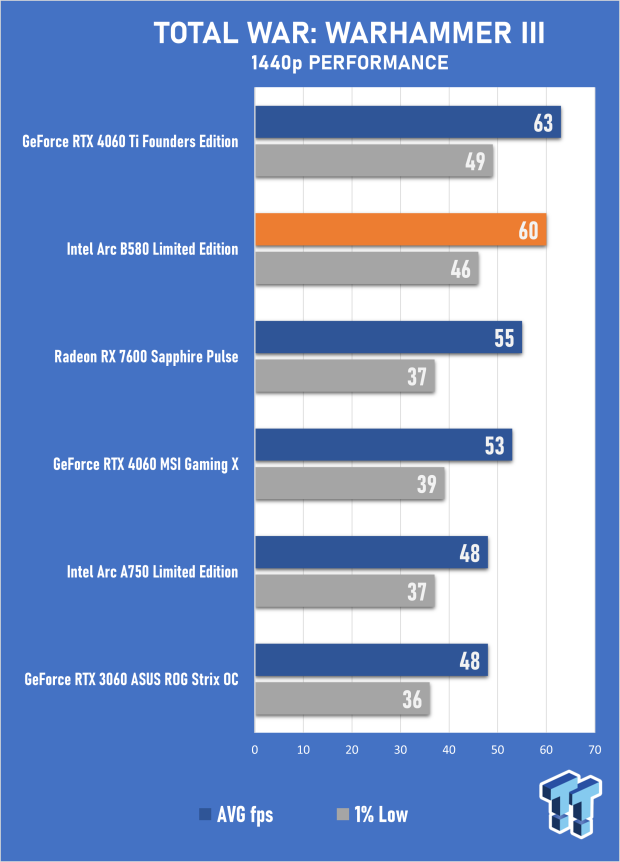
Benchmarks Summary, Ray-Tracing Performance, and XeSS
As a mainstream new sub-$300 GPU, a rarity in 2024, the Intel Arc B580 offers a compelling alternative to the GeForce RTX 4060. At 1080p, the two cards trade blows, while the 12GB of VRAM ensures that it pulls ahead at 1440p, as seen in Horizon Forbidden West, where it even eclipses the GeForce RTX 4060 Ti. For pure 1080p gaming, NVIDIA's DLSS and Frame Generation have the edge regarding image quality and support - with DLSS 3 supported by a wide range of titles. Also, the RTX 4060 is a far more efficient GPU, delivering its performance using upwards of 40% less power. This means that the B580 delivers its performance advantage by utilizing much more energy, which must be factored into the overall story.
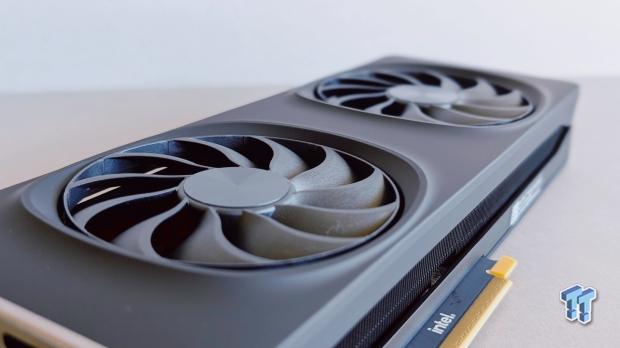
However, as Intel's XeSS is AI-powered, it delivers superior image quality to AMD's FSR and is worth enabling at 1440p and 1080p using the equivalent DLSS Quality setting. At 1080p, you do sacrifice image fidelity for performance, but it's a must for titles with ray-tracing, like Cyberpunk 2077 and Dying Light 2. On the plus side, XeSS was available in all the games we tested, including DLSS and FSR. Hence, it's something developers support and will continue to do so, thanks to Intel utilizing Arc Graphics for its integrated graphics.
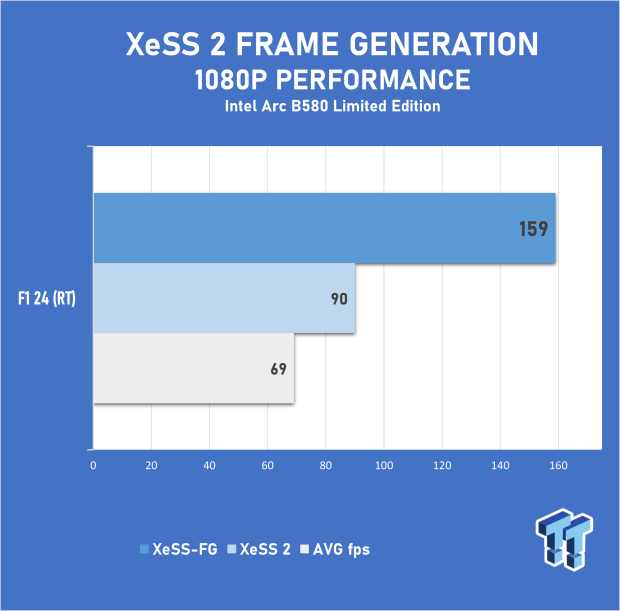
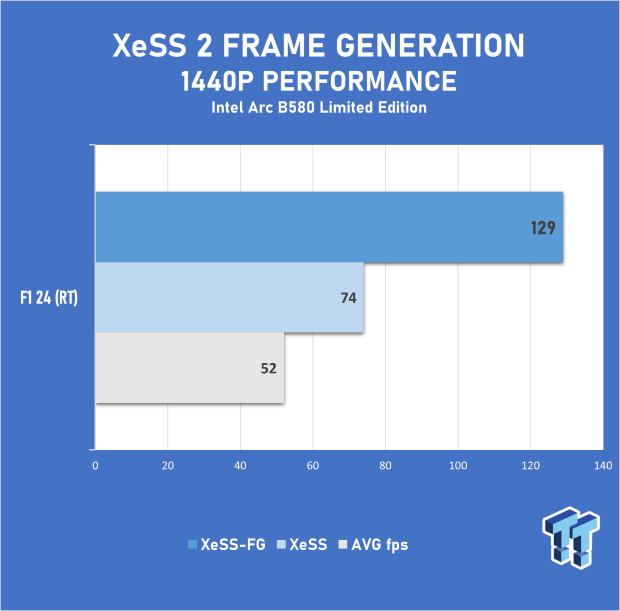
With the Intel Arc B580, we've also got the debut of XeSS 2, which includes Intel's AI-powered frame generation technology. It's only available in a single game, F1 24, which we could test at 1080p and 1440p. With the addition of Intel's new low-latency technology, you're looking at a significant performance boost without additional input latency. At 1080p, we see a 2.3X increase in performance, while at 1440p, we see a 2.5X increase in performance. We did notice some visual artifacts with XeSS 2 Frame Generation that weren't present when using DLSS 2 Frame Generation on the RTX 4060. However, the latency and effect are impressive. Still, as it requires game implementation, we might never see a situation where there are as many games with DLSS 3 support as XeSS 2 support.
Temperature and Power Efficiency
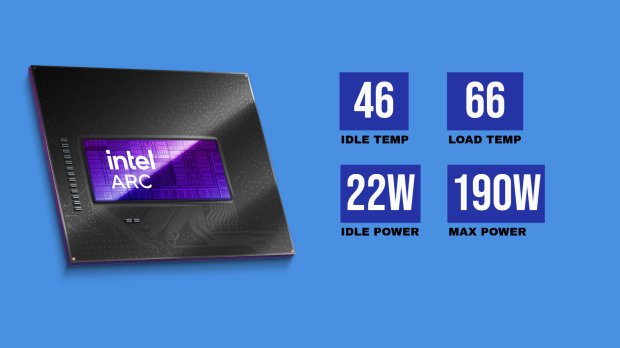
The Intel Arc B580 Limited Edition is a great-looking minimal GPU that is whisper quiet even when under load, with temperatures remaining relatively cool even when stressed. As discussed, its 190W power rating is more power-hungry than the GeForce RTX 4060 and RTX 4060 Ti, with consumption being closer to the far more powerful GeForce RTX 4070. However, with partner B580 models supporting overclocking with an additional 8-pin power connector, extra performance can be obtained via the OC tools available in Intel's updated Graphics Software for Arc GPUs.
Final Thoughts
From installation to benchmarking, we only encountered a single game crash. Overall, the Intel Arc B580 is impressively stable. Intel's new software also delivers more control over the Intel Arc B580 with in-depth performance metrics, expanded display controls, and a powerful overclocking suite that can improve performance. Again, it's a night and day difference compared to the first-generation Intel Arc A750 launch, with performance that makes a compelling argument for picking this up over a GeForce RTX 4060. With 12GB of VRAM, it's also better equipped for modern titles that require more memory when using Ultra-equivalent settings.
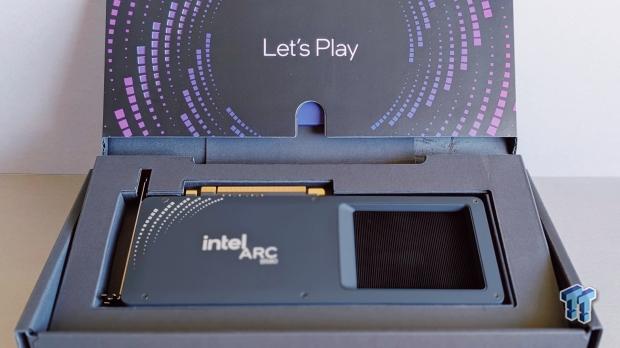
It's not perfect, and the GeForce RTX 4060 benefits from NVIDIA's full suite of application support, content creation features, AI readiness, and widespread support for DLSS and DLSS 3. This will always make an alternative from Intel or AMD an uphill battle or hard sell, as familiarity and security come with choosing an established and reliably impressive brand or product.
The Intel Arc B580 includes excellent encoding support for content creators and AI hardware, too, so it isn't lacking in any one area. XeSS 2 Frame Generation is also promising, but it's starting from behind and playing catch-up. This is probably why Intel landed at the $249 price point, which is $50 cheaper than the GeForce RTX 4060 MSRP and $20 cheaper than the Radeon RX 7600 MSRP.
The Intel Arc B580 is a mainstream winner, a GPU that delivers competitive performance across all metrics - including ray tracing. As mentioned earlier in this review, it makes the Radeon RX 7600 irrelevant while bringing the fight to the GeForce RTX 4060. Of course, the situation could easily change when the GeForce RTX 5060 and Radeon RX 8600 hit the scene, but they could both be months from release.
Right now, the Intel Arc B580 offers excellent value for its price point. The 12GB of VRAM opens the door to more 1440p gaming than its competition can handle while also adding some peace of mind that it'll be able to handle the latest releases coming down the pipe in 2025. Intel Arc 2.0 is a win - bring on the Intel Arc B750.

